08.23.10
Posted in Tropical Weather, Weather News at 6:14 pm by Rebekah
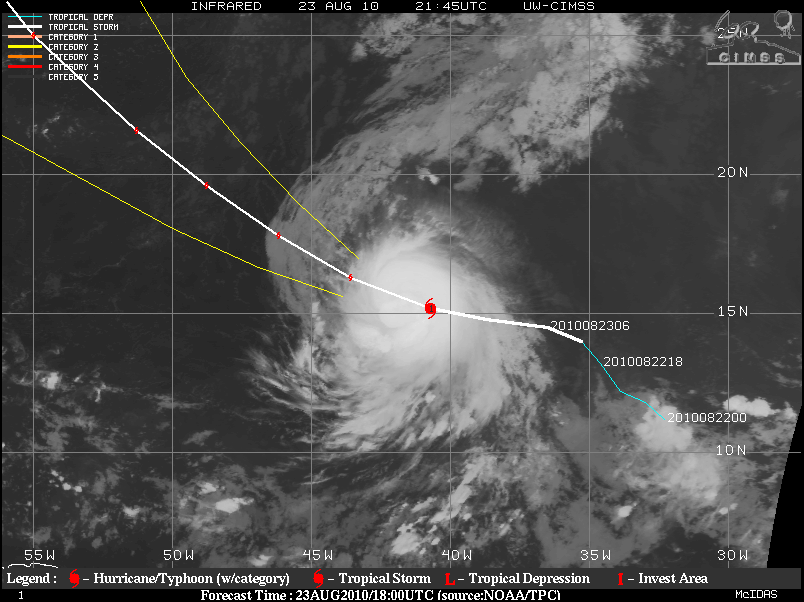
Danielle was upgraded to hurricane status this evening, with peak sustained winds of 75 mph (satellite image from CIMSS, taken at 2145 UTC, or 5:45 pm EDT).
The National Hurricane Center is forecasting that Danielle will reach Category 3 status (111 to 130 mph), peaking around 115 mph, on Wednesday evening.
Here’s a model intensity forecast again from Weather Undergound:
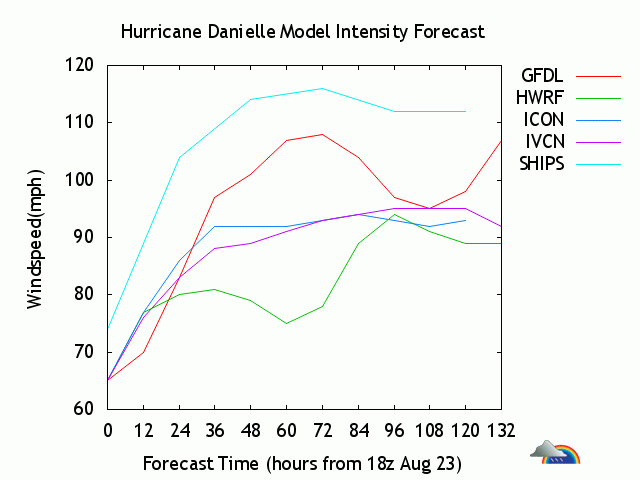
Danielle remains no threat to land; she should start recurving back north and eventually east by the time she gets east of Bermuda (NHC forecast track below).
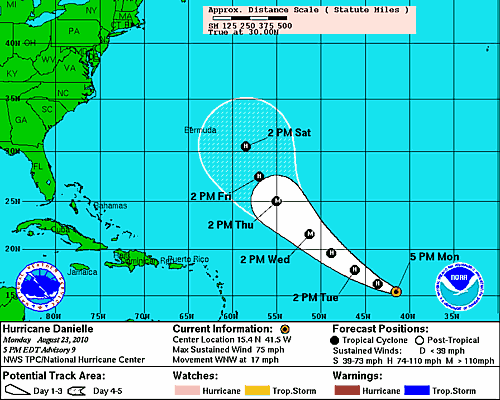
Meanwhile, back where Danielle first formed, just south of the Cape Verde Islands, another disturbance is starting to organize. This area of low pressure is also in a favorable area for development, and the NHC believes there is a 40% chance of this system becoming a tropical cyclone within the next 48 hours.
Models show that this disturbance could become a tropical storm in the next few days, if it can hold together that long.
The next name on the Atlantic storms list is Earl.
In the eastern Pacific, Tropical Storm Frank is struggling with wind shear just southwest of Mexico, but is expected to become a weak hurricane after a couple days, once he gets into an area of weaker shear. Frank is not a threat to Mexico, but is forecast to move parallel up the coast towards the northwest.
Permalink
08.22.10
Posted in Tropical Weather, Weather News at 3:59 pm by Rebekah
Tropical Depression 6 has just been upgraded to Tropical Storm Danielle.
Some vertical shear and dry air will prevent Danielle from strengthening as fast as was previously expected, but it is still expected to become a hurricane by Wednesday afternoon.
Danielle is moving towards the northwest at present, but is forecast to turn to the west-northwest as it will be steered by a subtropical ridge to its north.
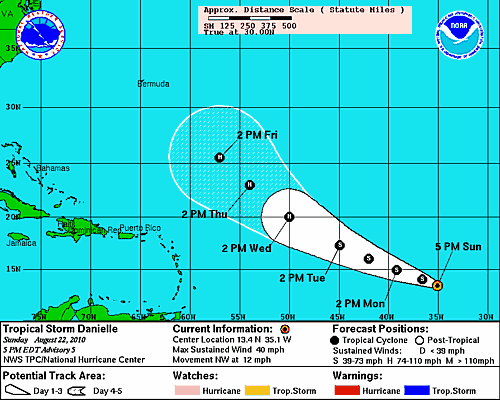
Model intensity forecast, from Weather Underground:
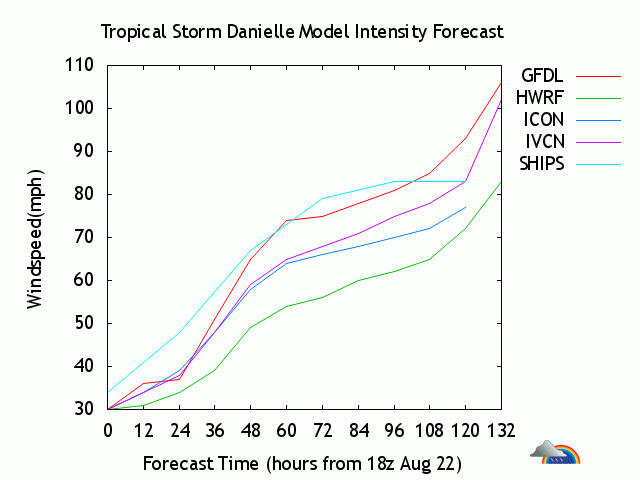
Permalink
08.21.10
Posted in Severe Weather Post-analysis, Weather News at 11:50 pm by Rebekah
A microburst on the northeast side of Norman this evening left over 500 homes and businesses without power.
I received a trace of rain and heard a bit of thunder at my apartment on the north side of town, but looked at the radar and saw what I thought was just a small, weak thunderstorm. The wind blew a little bit, but only gusted to 32 mph at the airport.
On my way to a School of Meteorology get-together, I saw the road was blocked as a power pole was laying down in the road. Another power pole nearby was snapped about a third of the way up, and all of the traffic lights in that area were either not working or blinking red.
I noticed later that a local storm report for north Norman at 7 pm local time (CDT) read: “FROM 650-700PM NUMEROUS REPORTS OF DAMAGE BETWEEN 12TH AND 24TH BETWEEN ROBINSON AND ALAMEDA. 4 INCH DIAMETER LIMBS DOWN, POWER POLES SNAPPED, SHINGLES BLOWN OFF HOUSES.”
Here’s what the Oklahoma City TWDR (high-resolution radar) looked like at 6:51 pm CDT (from Weather Underground).
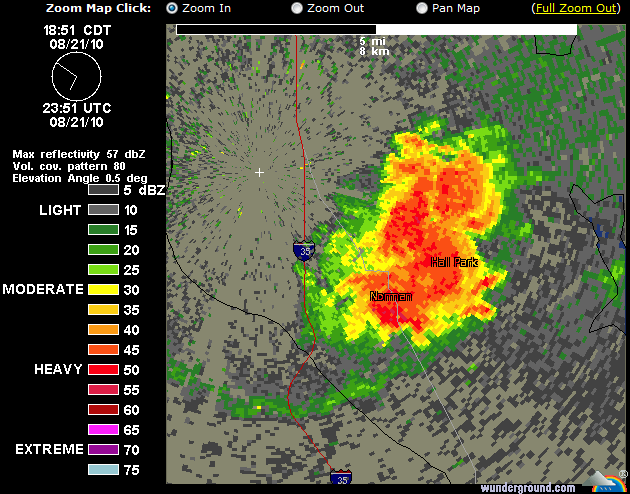
It doesn’t look like anything special, but now take a look at a base velocity image for the same time.
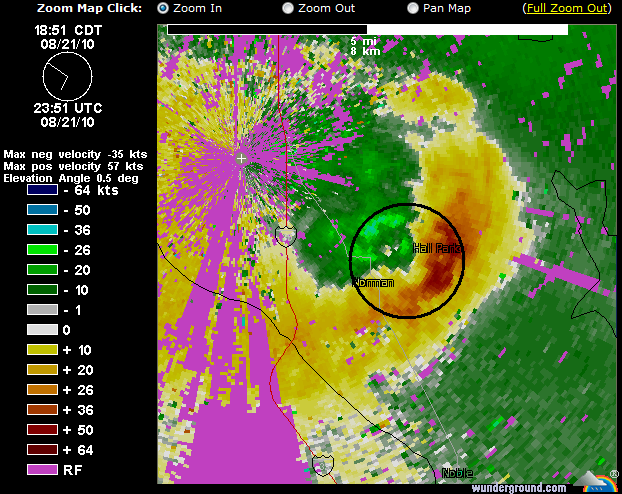
Note the area of orange and green between Norman and Hall Park (circled). This is a pretty classic microburst signature.
Negative numbers (green and blue colors) mean the wind is blowing towards the radar (location marked at the white “+” in the upper left), while positive numbers (yellow and orange) mean the wind is blowing away from the radar.
In this case, fairly strong winds are diverging over a small area between Norman and Hall Park. The radar estimates winds of 36 knots moving towards the radar and winds of 64 knots moving away from the radar, equating to 100 knots (115 mph) wind shear over about a 2 mile distance.
A microburst is a small column of rapidly descending air, which hits the ground and spreads out fast. A microburst is a type of downburst that occurs over a very localized area, defined as 2.5 miles in diameter or less. Microbursts/downbursts can occur as a thunderstorm is dying, and are capable of producing straight-line surface winds of over 150 mph.
Finally, here’s a meteogram from the Norman mesonet station, showing how several meteorological parameters have changed over the last 24 hours.
Note several things (this station is near the airport, and not quite on the northeast side of Norman):
- rapid drop in temperature between 6 and 7 pm (when the storm rolled through)
- increase in dewpoint at the same time, when it began to rain
- increase in wind speed and fluctuations in wind direction
- pressure rise
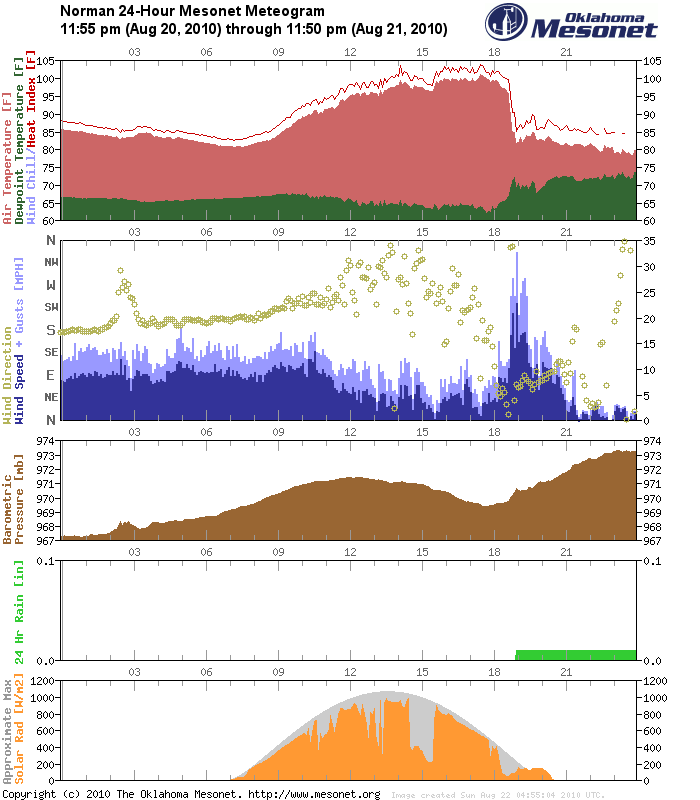
Also, take a look at the solar radiation plot–the gray area shows the maximum amount of solar radiation that we could be receiving this day, while the orange area shows the amount of solar radiation we actually did receive.
The orange area dips down whenever clouds pass over, and goes back up when it gets sunnier. Now note what happened just as the sun went down–the actual solar radiation was HIGHER than the maximum possible solar radiation! What’s up with that?
As I went out tonight, I saw everything bathed in orange. The sun was just going down, but the storm was to my southeast and the anvil was covering the sky. The sun was on the horizon, so the low beams of the sun bounced off the clouds just right and back towards earth, providing us with more solar radiation than we would have otherwise received.
Permalink
Posted in Tropical Weather, Weather News at 4:02 pm by Rebekah
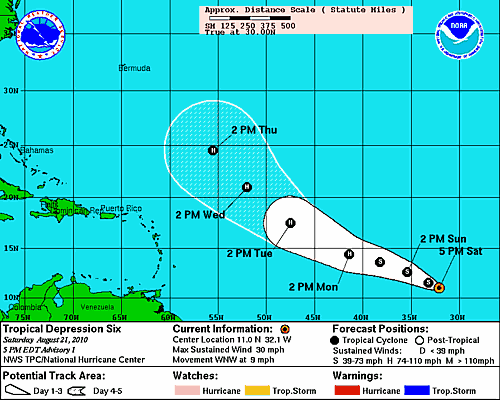
Last night I posted on a tropical disturbance off the Cape Verde Islands that had the potential to become a hurricane within a few days.
Within the last hour, this system has become organized enough for the National Hurricane Center to upgrade it to Tropical Depression 6 (TD6). The above map shows the NHC forecast track. They have it becoming Tropical Storm Danielle sometime tonight, and a hurricane by Monday afternoon.
The NHC discussion on TD6 mentions “the NHC forecast is close to the SHIPS/LGEM models…showing a large powerful hurricane over the central Atlantic Ocean in a few days.”
Here’s a model intensity forecast for TD6 from Weather Underground, showing the results of 4 different models. Keep in mind that forecast intensity is not always very good very far out.
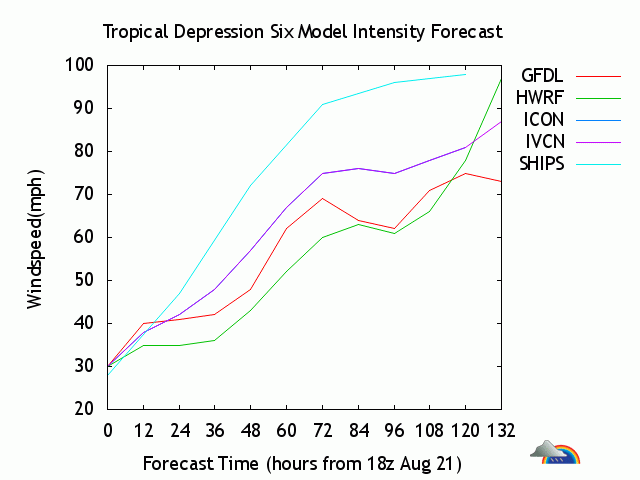
Category 1 hurricanes have winds of 74 to 95 mph and Category 2 have winds of 96 to 110 mph.
Stay tuned.
Permalink
08.20.10
Posted in Tropical Weather, Weather News at 9:37 pm by Rebekah
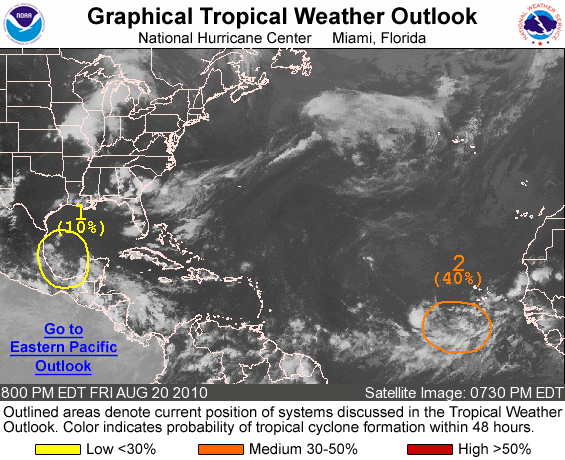
An area of low pressure just southwest of the Cape Verde Islands shows some promise for tropical development within the next several days (#2 on the NHC graphic above).
In an area with sea-surface temperatures in the mid- to upper 80s and deep layer wind shear of 10 to 15 knots (and moving into even warmer waters and calmer winds aloft), this low has the potential to become a tropical storm by early next week.
Several models are showing this system rapidly developing into a hurricane, possibly a strong hurricane, by the middle of the week. Models also show that the possible hurricane would likely recurve back eastward before it ever came close to land.
It has been a quiet start to the hurricane season in the Atlantic, but we are nearing the peak of the season, so we’ll probably start to see things picking up soon.
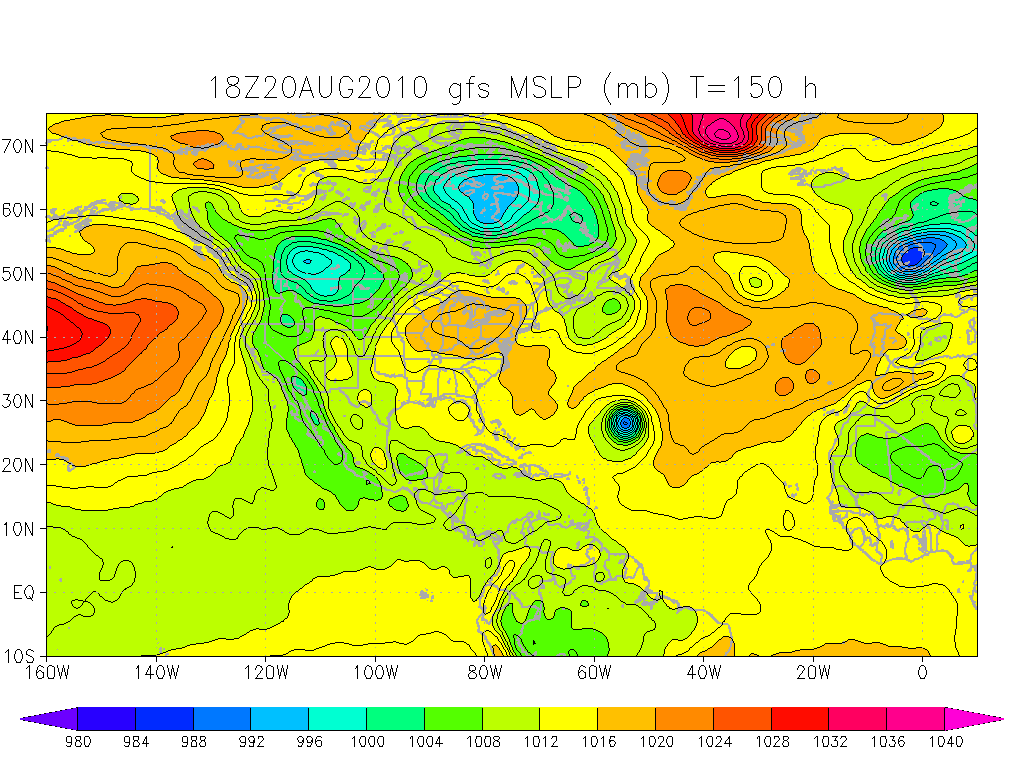
Sea-level pressure, GFS model, valid for 00Z on the 27th (Thursday night). Note the area of low pressure in the Atlantic. Click to enlarge.
Permalink
« Previous Page — « Previous entries « Previous Page · Next Page » Next entries » — Next Page »











